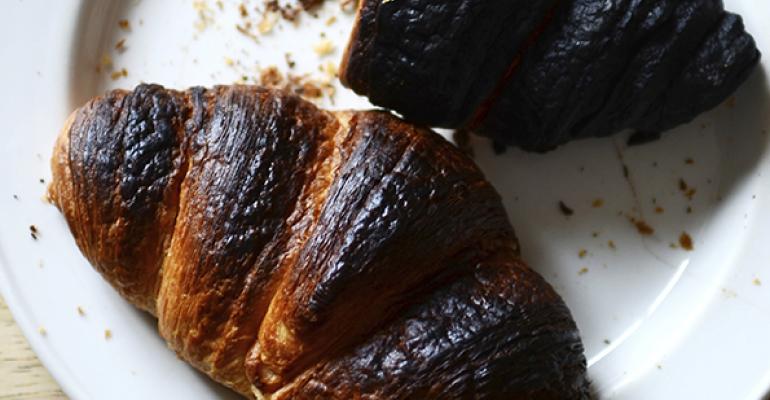That smell of something burning that’s wafting out of kitchens around the country? It’s doubtless a reflection of the growing popularity of charring as a prep technique of choice. Restaurant patrons have had a long-running love affair with smoking, and operators have responded with a dizzying array of smoked foods, beverages and even ice cubes. Now they’re upping the ante and playing with fire as they char foods in order to impart both texture and flavor.
In some ways this development is a bit of déjà vu, since charbroiling was once broadly employed in commercial kitchens. Over time, its popularity was eclipsed by grilling, which features visible hash marks that suggest the live-fire cooking prized by patrons. Now the advent of New Nordic cuisine with its emphasis on earthy flavors and the reconsideration of charring by its leading practitioners have given it a new lease on life.
Dishes are scorching hot. Independent restaurateurs have embraced charring and use it all across the menu. The Little Beet, located in New York City and dedicated to local and seasonal cuisine, chars string beans, cauliflower, broccoli and kale. Marco’s in Brooklyn takes an edgier approach with Charred Duck Hearts and Gizzards, skewered and served with a Concord-grape mostarda; less adventurous patrons might opt instead for the simple wood-grilled bread or oysters. In Atlanta, King + Duke features a 24-foot open hearth and dishes up charred tomato soup, while across town The Bishop pours seasonal cocktails made with charred oak bourbon. Meanwhile, Ribelle, located in Brookline, Mass., reportedly scored a big hit with Charred Kale Salad, plated with oyster crema and Anaheim peppers.

Chains have jumped on the bandwagon, too. Veggie Grill’s summer menu included Chargrilled Street Corn, which was served on the cob with Southwestern mayonnaise, soy Parmesan and cilantro; there were also chargrilled peaches on a salad and chargrilled portobello mushrooms in an entrée. Zinburger Wine & Burger Bar’s annual contest invites diners to create burger recipes, and this year’s winner, which appeared systemwide in September, was the Honolulu Baby Burger topped with charred pineapple. The Habit Burger Grill, an early entrant in the better-burger category, built its business on the Charburger, a signature sandwich chargrilled over an open flame. The menu comprises specialties like the Teriyaki and BBQ Bacon Charburgers. And Maggiano’s recently debuted a Lighter Take menu, featuring reduced-calorie fare. Among the offerings is Chicken Marsala finished with a “char crust “made from coffee, oregano, parsley and smoked salt.
They’re turning to ash. While charring is in the spotlight, operators are aggressively utilizing a broad range of techniques that combine live fire with culinary expertise to create dishes that consumers can’t easily replicate at home. Fine-dining chefs have been experimenting with ash, another approach found in trendy Nordic operations. Aquavit in New York City has used ash made from hay to smoke sweetbreads, and Sixteen in Chicago uses ash powder made from dehydrated vegetables to roast venison. The Restaurant at Meadowood in Napa Valley, Calif., uses volcanic ash as a cooking medium, a reflection of the volcanic soil prevalent in the area.
While ash is unlikely to appear on chain menus any time soon, they are sizzling nonetheless. Mellow Mushroom’s “Up in Smoke” menu promoted a Fully Blazed Chicken Mole Pie along with a Smokin’ Shrimp Calzone, while Grimaldi’s Coal Brick-Oven Pizzeria is one of a number of pizza specialists who use coal-burning ovens to impart a unique flavor and crispy crust to their pies. Wendy’s touts the fire-roasted edamame and spicy roasted cashews atop its Asian Cashew Chicken Salad.
Looking ahead, chefs will experiment with flavor synergies by creatively combining ingredients with cooking mediums. Look for them to double down on smoking and barbecue, proven patron pleasers that adapt well to flavor enhancement. TGI Friday’s Rib Flight Trio promotion, for example, includes a Chipotle Smoked BBQ Sauce that brings out the smoke inherent in the chile. When Red Robin launched its premium Finest Burgers line, it led with the Finest Smoke & Pepper Signature Burger that boasted a double dose of smoke via alderwood-smoked sea salt and house-made smoke & pepper ketchup.
Nancy Kruse, President of the Kruse Company, is a menu trends analyst based in Atlanta. As one of LinkedIn’s Top 100 Influencers in the U.S., she blogs regularly on food-related subjects on the LinkedIn website.





